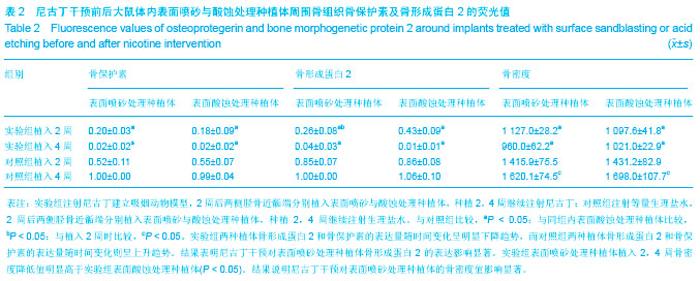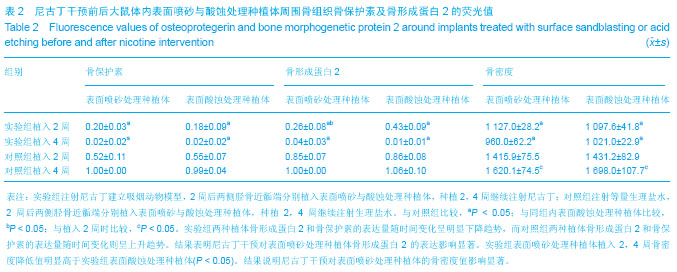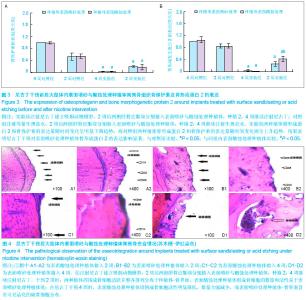Chinese Journal of Tissue Engineering Research ›› 2014, Vol. 18 ›› Issue (8): 1149-1154.doi: 10.3969/j.issn.2095-4344.2014.08.001
Nicotine effects on the osseointegration of implants with different treatments
Sun Xin, Hou Yu-dong, Teng Teng, Xue Peng-fei, Liu Shun-zhen
- School of Stomatology, Binzhou Medical College, Yantai 264003, Shandong Province, China
-
Received:2013-12-06Online:2014-02-19Published:2014-02-19 -
Contact:Hou Yu-dong, Professor, School of Stomatology, Binzhou Medical College, Yantai 264003, Shandong Province, China -
About author:Sun Xin, Studying for master’s degree, School of Stomatology, Binzhou Medical College, Yantai 264003, Shandong Province, China -
Supported by:the Medical and Health Scientific Development Plan of Shandong Province, No. 2013ws0299
CLC Number:
Cite this article
Sun Xin, Hou Yu-dong, Teng Teng, Xue Peng-fei, Liu Shun-zhen. Nicotine effects on the osseointegration of implants with different treatments[J]. Chinese Journal of Tissue Engineering Research, 2014, 18(8): 1149-1154.
share this article
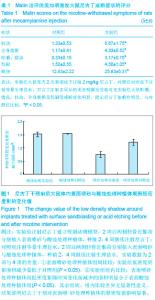
2.1 大体观察 大鼠术后状态良好,无异常死亡。尼古丁注射2周后的美加明激发实验可见大鼠咀嚼、措齿,抖动,全身震颤及舔脚等戒断症状明显,提示尼古丁依赖性明显(表1)。实验组种植体周围软组织红肿,部分呈充血状态,但无明显感染;取材时种植体有轻微松动,种植体取下时稍有阻力。对照组种植体周围骨愈合良好,周围软组织色泽、质地正常,取材时种植体稳固,种植体取下时阻力较大。 2.2 X射线与CT观察 X射线显示:①表面喷砂处理种植体组间比较:实验组低密度阴影面积减少量(0.74±0.12) mm2低于对照组(1.21±0.12) mm2(P < 0.05)。②表面酸蚀处理种植体组间比较:实验组低密度阴影面积减少量(1.52±0.09) mm2与对照组(1.54±0.01) mm2差异不明显。③实验组组内比较:表面喷砂处理种植体组低密度影随时间变化而减少的面积明显小于表面酸蚀处理种植体组(P < 0.05)。④对照组组内比较:两种植体之间低密度影随时间变化而减少的面积无差异。具体结果见图1。"

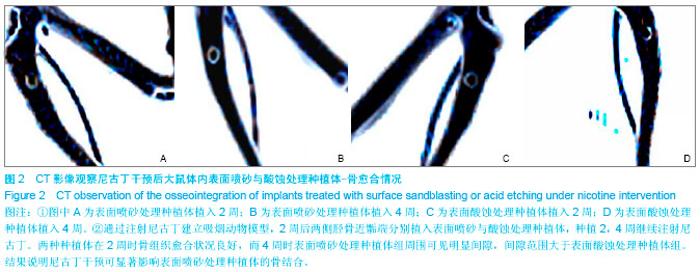
CT图像:可见种植第2周和第4周时,对照组两种植体周围骨愈合情况均较好,且组间差异不明显;实验组两种种植体在2周时骨组织愈合状况良好,而4周时表面喷砂处理种植体组周围可见明显间隙,间隙范围大于表面酸蚀处理种植体组(图2)。CT骨密度值显示,2周时实验组两种植体周围的骨密度值均低于对照组(P < 0.05),但实验组和对照组组内表面酸蚀处理种植体与表面喷砂处理种植体骨密度值差异不明显;4周时实验组和对照组组内表面酸蚀处理种植体与表面喷砂处理种植体的骨密度值也无明显差异,但对照组两种植体周围骨密度值随时间变化升高趋势明显 (P < 0.05),而实验组呈下降趋势,且表面喷砂处理种植体组种植体周围骨密度值的降低趋势更为明显(P < 0.05,表2)。 2.3 荧光定量PCR检测骨保护素与骨形成蛋白2的表达 实验组两种植体骨形成蛋白2和骨保护素的表达量随时间变化呈明显下降趋势,而对照组两种植体骨形成蛋白2和骨保护素的表达量随时间变化则呈上升趋势。种植后第2周时可见,实验组组内表面酸蚀处理种植体周围骨形成蛋白2的表达量低于表面喷砂处理种植体(P < 0.05),而两种植体在骨保护素面的表达量则无明显差异;第4周时,两种植体周围骨形成蛋白2和骨保护素的表达量均出现明显下调,二者差异不明显。实验组两种植体周围骨形成蛋白2和骨保护素的表达量均低于各自的对照组(P < 0.05,图3,表2)。 2.4 组织学观察 苏木精-伊红染色显示,植入第2周与第4周时,对照组大鼠种植体周围成骨细胞的活性和数量均明显高于实验组。而尼古丁干预2周时,两种植体周围成骨细胞活跃并整齐排列分布于种植体-骨界面,表面酸蚀处理种植体组成骨细胞的数量和活性高于表面喷砂处理种植体组;在尼古丁干预4周时,表面酸蚀处理种植体周围成骨细胞活性明显降低,数量大幅减少,而表面喷砂处理种植体-骨界面甚至可见活化的破骨细胞分布(图4)。"
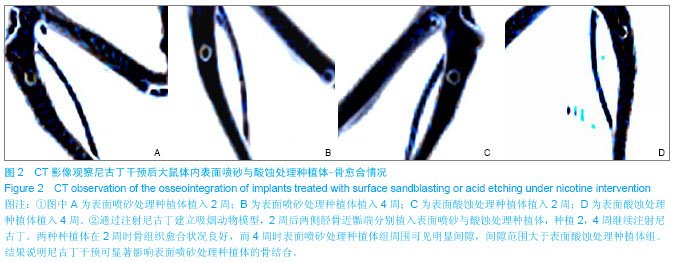
| [1] Wu K,Song W,Zhao L,et al.MicroRNA Functionalized Microporous Titanium Oxide Surface by Lyophilization with Enhanced Osteogenic Activity.ACS Appl Mater Interfaces. 2013;5(7):2733-2744. [2] Akin H,Guney U.Effect of various surface treatments on the retention properties of titanium to implant restorative cement.Lasers Med Sci.2012;27(6):1183-1187. [3] Aparicio C,Manero JM,Conde F,et al.Acceleration of apatite nucleation on microrough bioactive titanium for bone-replacing implants.J Biomed Mater Res. 2007;82: 521-529. [4] Prodanov L,Lamers E,Domanski M,et al.The effect of nanometric surface texture on bone contact to titanium implants in rabbit tibia. Biomaterials. 2013;34(12):2920- 2927. [5] Zhang F,Zhang CF,Yin MN,et al.Effect of heat treatment on H2O2/HCl etched pure titanium dental implant:an in vitro study.Med Sci Monit.2012;18(7):265-272. [6] Yamada M,Ueno T,Minamikawa H,et al.Early-stage osseointegration capability of a submicrofeatured titanium surface created by microroughening and anodic oxidation. Clin Oral Implants Res.2013;24(9):991-1001. [7] Akhter MP,Lund AD,Gairola CG.Bone biomechanical property deterioration due to tobacco smoke exposure.J Bone Miner Res.2005;77(5):319-326. [8] Korpelainen R,Korpelainen J,Heikkinen J,et al.Lifelong risk factors for osteoporosis and fractures in elderly women with low body mass index-A population-based study.Bone.2006; 39(2): 385-391. [9] Silcox D, Daftari KT,Bodden MK,et al.The effect of nicotine on spine fusion.Spine (Phila Pa 1976).1995;20:1594-1553. [10] Sherwin M,Gastwirth C.Detrimental effects of cigarette smoking on lower extremity wound healing.J Foot Surg.1990;29:84-87. [11] Raikin SM,Landsman JC,Alexander VA,et al.Effect of nicotine on the rate and strength of long bone fracture healing. Clin Orthop Relat Res.1998;353:231-237. [12] Alzoubi KH,Srivareerat M,Tran TT,et al.Role of α7- and α4β2-nAChRs in the neuroprotective effect of nicotine in stress-induced impairment of hippocampus-dependent memory.Int J Neuropsychopharmacol.2013;16(5):1105-1113. [13] Berley J,Yamano S,Sukotjo C.The effect of systemic nicotine on osseointegration of titanium implants in the rat femur.J Oral Implantol. 2010;36(3):185-193.[14] 刘献文,逯素芬,于爱兰,等.改良尼古丁依赖_戒断大鼠模型的建立与疼痛敏感性观察[J].国际麻醉学与复苏学杂志,2013,34(7):591-640.[15] Malin DH,Lake JR,Newlin-Maultsby P,et al.Rodent model of nicotine abstinence syndrome.Pharmacol Biochem Behav. 1992;43(3):779-784.[16] Duarte PM,de Mendonga AC,Maximo MB,et al.Differential cytokine expressions affect the severity of peri-implant disease. J Clin Oral Implants Res.2009;20(5):514-520. [17] Hofbauer LC,Khosla S,Dunstan CR,et al.The roles of osteoprotegerin and osteoprotegerin ligand in the paracrine regulation of bone resorption.J Bone Miner Res.2000;15(1): 2-12.[18] Derynck R,Zhang Y.Smad-dependent and Smad-independent pathways in TGF-beta family signaling.Nature. 2003;425(6958):577-584. [19] Schmierer B,Hill CS.TGF beta-SMAD signal transduction: molecular specificity and functional flexibility. Nat Rev Mol Cell Biol.2007;8(12):970-982.[20] Akin H,Guney U.Effect of various surface treatments on the retention properties of titanium to implant restorative cement.Lasers Med Sci.2012;27(6):1183-1187. [21] 孙轲,侯玉东.烟草浸提液对牙龈成纤维细胞在钛板上粘附增殖的影响[J].实用口腔医学杂志,2009,25(1):80-83. [22] 侯玉东,沈建英,王桂龙,等.烟草浸提液对大鼠成骨细胞在钛板上附着和增殖的影响[J].实用口腔医学杂志, 2011,27(1):17-20.[23] Egger P,Duggleby S,Hobbs R,et al.Cigarette smoking and bone mineral density in the elderly.J Epidemiol Community Health.1996;50:47-50.[24] Lemons JE,Laskin DM,Roberts WE,et al.Changes in patient screening for a clinical study of dental implants after increased awareness of tobacco use as a risk factor.J Oral Maxillofac Surg.1997;55:72-75. [25] Yamano S,Berley JA,Kuo WP,et al.Effects of nicotine on gene expression and osseointegration in rats.Clin Oral Implants Res. 2010;21(12):1353-1359. [26] Pereira ML,Carvalho JC,Peres F,et al.Simultaneous effects of nicotine, acrolein, and acetaldehyde on osteogenic-induced bone marrow cells cultured on plasma-sprayed titanium implants.Int J Oral Maxillofac Implants.2010;25(1):112-122. [27] Hoffmann D,Hoffmann I.The musculoskeletal effects of smoking.J Am Acad Orthop Surg.2001;9:9-17. |
| [1] | Huo Hua, Cheng Yuting, Zhou Qian, Qi Yuhan, Wu Chao, Shi Qianhui, Yang Tongjing, Liao Jian, Hong Wei. Effects of drug coating on implant surface on the osseointegration [J]. Chinese Journal of Tissue Engineering Research, 2021, 25(22): 3558-3564. |
| [2] | Li Ping, Lin Yu, Chen Xiang, Liu Zhentao, Xiao Lili, Lin Xueyi, Hua Peng . Characteristics of bone remodeling in female ovariectomized rat models of osteoporosis undergoing Erzhi Pill extract intervention [J]. Chinese Journal of Tissue Engineering Research, 2021, 25(2): 191-195. |
| [3] | Liu Hong, Wan Zhe, Zhang Zhen, Zhang Qin. Relationship between root resorption and intrusive force during maxillary molar intrusion in Beagle dogs [J]. Chinese Journal of Tissue Engineering Research, 2021, 25(14): 2172-2176. |
| [4] |
Zhang Xuan, Li Yunpeng, Zhang Xuejian, Yin Chuanrong, Deng Yue.
Guided bone regeneration using preformed titanium mesh combined with bioabsorbable membranes in aesthetic area [J]. Chinese Journal of Tissue Engineering Research, 2020, 24(26): 4112-4117. |
| [5] | Yuan Bo, Wang Zhiwei, Tang Yifan, Zhou Shengyuan, Chen Xiongsheng, Jia Lianshun. Construction of polycaprolactone-tricalcium phosphate with different mixture ratios using three-dimensional printing technology and its osteoinductivity in vitro [J]. Chinese Journal of Tissue Engineering Research, 2019, 23(6): 821-826. |
| [6] | Wang Xuefeng, Shang Xifu . Curative effects of three filling materials in the treatment of osteoporotic thoracolumbar fractures [J]. Chinese Journal of Tissue Engineering Research, 2019, 23(6): 863-869. |
| [7] | Liu Dan, Min Changqin, Lu Shuai, Chen Yue, Sun Yong. Osseointegration induced by beta-tricalcium phosphate loaded with advanced platelet-rich fibrin [J]. Chinese Journal of Tissue Engineering Research, 2019, 23(6): 888-893. |
| [8] | Li Fang, Cheng Yuting, Huang Xiaolin, Zhou Qian, Wu Chao, Shi Qianhui, Wang Yong, Liao Jian. Maxillary sinus floor augmentation: with or without bone grafting [J]. Chinese Journal of Tissue Engineering Research, 2019, 23(6): 971-977. |
| [9] | Tang Xianneng, Chen Yueping, Zhang Xiaoyun. Clinical application of bone morphogenetic proteins in bone and cartilage tissue engineering [J]. Chinese Journal of Tissue Engineering Research, 2019, 23(4): 591-596. |
| [10] | Liu Junyin, Feng Wei, Xie Yingchun, Li Yuwan, Zeng Jitao, Liu Ziming, Tu Xiaolin. Bone morphologic protein signaling pathway in bone regeneration and repair: accurate regulation and treatment targets [J]. Chinese Journal of Tissue Engineering Research, 2019, 23(4): 606-612. |
| [11] | Liu Shuzhong1, Lao Lifeng2. Effects of recombinant human bone morphogenetic protein-2 on the proliferation of breast cancer MCF-7 cells [J]. Chinese Journal of Tissue Engineering Research, 2019, 23(3): 458-463. |
| [12] | Wei Wei, Liu Yanfei, Zhang Ling, Xiong Na . Self-assembling peptide hydrogel: hemostatic effect and mechanism [J]. Chinese Journal of Tissue Engineering Research, 2019, 23(2): 310-316. |
| [13] | Zou Yingnan, Wang Yibo, Ding Chao, Pan Xinyu, Shi Jiuhui . Three-dimensional finite element analysis of dental implant combined with residual tooth after hemisection under dynamic loads [J]. Chinese Journal of Tissue Engineering Research, 2019, 23(2): 178-183. |
| [14] | Lu Yanqin, Yi Fang, Ju Wei, Li Wenjie, Lei Lei. Reparation of femoral defects with a Ca-P coated magnesium alloy scaffold carrying sustained release microspheres [J]. Chinese Journal of Tissue Engineering Research, 2019, 23(2): 232-238. |
| [15] | Li Haoliang, Wang Xibin, Zuo Ruiting. Calcium phosphate cement/fibrin glue composite loaded with recombinant human bone morphogenetic protein 2 promotes osteoporotic fracture healing [J]. Chinese Journal of Tissue Engineering Research, 2019, 23(14): 2156-2161. |
| Viewed | ||||||
|
Full text |
|
|||||
|
Abstract |
|
|||||
